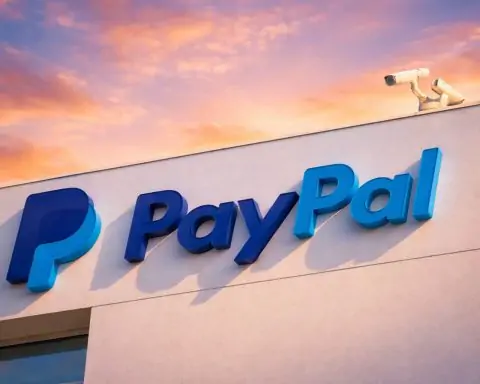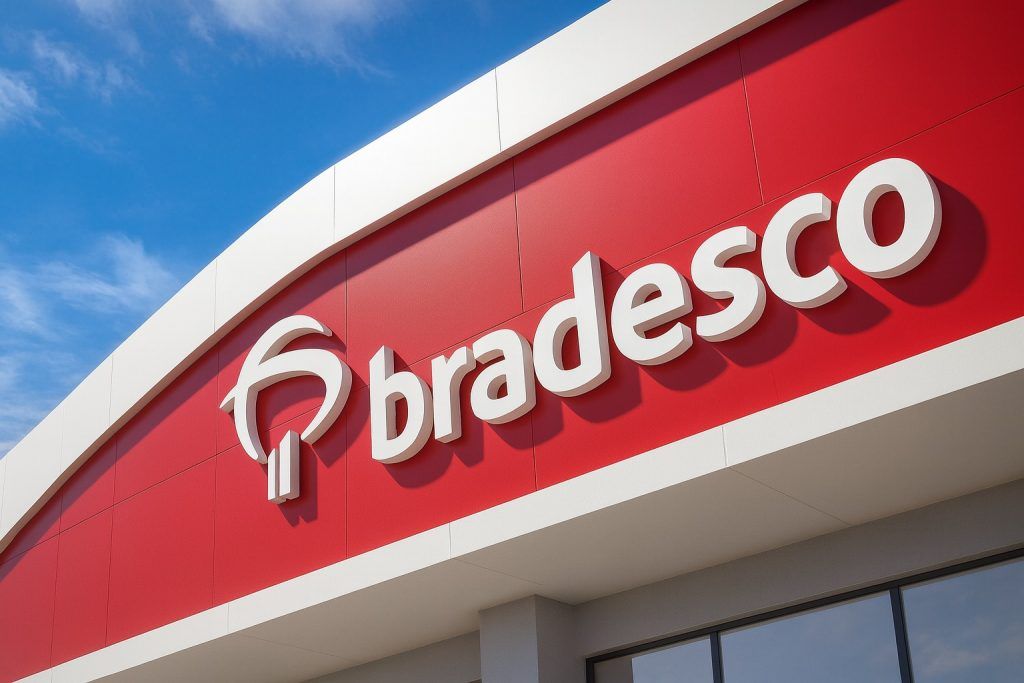- Spectacular Rally: SoFi Technologies (NASDAQ: SOFI) stock has surged about 230% over the past year, recently trading around the high-$28 range – near its 52-week high of ~$30.30 set in late September [1]. The stock is up roughly 70% year-to-date, outperforming most fintech peers in 2025.
- Latest Price & Recent Performance: As of October 23, 2025, SOFI hovers around $28.8 per share [2]. After a volatile early October (including a 5% one-day drop on Oct. 16 to ~$26.60 [3]), the stock rebounded ~8% on Oct. 20 following an analyst upgrade, regaining momentum ahead of earnings [4]. Heavy trading volumes (56+ million shares on Oct. 21) underscore intense interest – but also high volatility (SOFI’s beta ~1.9, nearly twice the market’s volatility) [5].
- Upcoming Earnings Catalyst:SoFi reports Q3 2025 earnings on October 28. Wall Street forecasts ~$880 million in revenue (+27% YoY) and EPS of ~$0.08 (+60% YoY) [6], a testament to SoFi’s rapid growth. Last quarter, SoFi beat estimates (Q2 EPS $0.08 vs $0.06 expected) and raised its full-year revenue guidance to ~$3.37 billion (+30% YoY) [7], so investors are eager to see if it can beat-and-raise again.
- Fintech Expansion & Partnerships: SoFi has aggressively expanded its one-stop financial platform in recent weeks. In early October it launched commission-free options trading for retail investors (allowing beginners to trade options with zero fees) [8]. It also rolled out a new AI-focused exchange-traded fund (ETF) in September (NASDAQ: AGIQ) targeting next-gen tech companies [9]. On the crypto front, CEO Anthony Noto revealed plans to enable blockchain-based international transfers via the Bitcoin Lightning Network by late 2025, and even to launch an FDIC-insured stablecoin once regulators allow [10]. Meanwhile, SoFi’s banking tech unit Galileo partnered with Amazon’s AWS in mid-October to broaden its cloud payments services [11]. These product moves aim to bolster SoFi’s growth and diversify its revenue.
- Student Loan Tailwind: SoFi’s roots in student loan refinancing mean policy shifts can be game-changers. This month brought a potential bombshell: the U.S. government is reportedly considering selling parts of its $1.6 trillion federal student loan portfolio to private lenders [12]. Such a move (still under discussion) could open a massive market for SoFi’s refinancing business [13]. Already, the resumption of federal student loan payments this fall has boosted activity – SoFi’s student loan refinancing volume jumped ~35% last quarter as borrowers exited the payment pause [14]. Mere speculation of a $1.6 trillion loan sale has added fuel to bullish sentiment on SoFi’s growth prospects, though no decisions are final [15].
- Analysts Split on Outlook: After its meteoric rise, expert opinions on SOFI are sharply divided. Bulls argue SoFi is executing well and still has room to run. Mizuho recently reiterated a “Buy” rating with a $31 price target, citing a strong outlook and benefits once interest rates eventually ease [16]. Some high-profile investors are optimistic too – “SoFi isn’t just another flashy meme-like fintech story – it’s a fast-growing business now proving its financial maturity,” says Michael Wiggins De Oliveira, a top-ranked analyst who rates the stock a Strong Buy [17]. On the other hand, skeptics warn that the valuation looks stretched after the huge rally. Morgan Stanley pegs fair value around $18 (Underweight/Sell), cautioning that at nearly 50× forward earnings the stock has “a lot of good news” already priced in [18]. Similarly, Keefe, Bruyette & Woods (KBW) analysts recently raised their target to $18 but still label SoFi “Underperform,” saying the risk/reward now “seems skewed negatively” given the premium valuation [19]. The average analyst stance is neutral – consensus rating Hold with an average 12-month target in the low-$20s, well below the current price [20].
2025 Rally & Recent Stock Performance 📈
SoFi’s stock has been on a roller-coaster rally throughout 2025. Over the past year, SOFI shares have more than tripled, rising from single digits to around $28–$29 today [21]. The stock hit an all-time high around $30.30 in late September amid fintech euphoria [22], marking its highest level in roughly four years. However, early October brought turbulence: profit-taking and broader market jitters sent SoFi sliding 10–15% off its peak [23]. In fact, the stock fell for seven straight sessions into mid-October, including a 5% plunge on Oct. 16 that briefly knocked shares down to about $26.60 [24]. “Most buyers are already in,” one analyst quipped during that pullback, suggesting the pool of new investors chasing the rally had shrunk [25].
Yet the bulls weren’t done. Starting October 20, SoFi stock sprang back to life – jumping nearly 8% intraday on Oct. 20 after Zacks Investment Research upgraded it to a “Buy” that morning [26]. By the next day, shares held those gains, closing around $28.75 on Oct. 21 [27]. At current levels (high-$28s), SoFi commands a market capitalization in the low-$30 billions, an eye-popping figure that rivals some established regional banks [28]. This highlights the market’s confidence in SoFi’s growth story – but also the rich valuation being assigned to a still-young fintech firm [29].
Trading activity in SOFI remains heavily elevated. Over 56 million shares traded on Oct. 21 (vs. a daily average closer to 20–30 million), and even the Oct. 16 sell-off saw volumes ~16% above average [30]. Such heavy volume reflects intense investor interest, but it’s a double-edged sword: SoFi is a volatile stock prone to big swings. Its beta of ~1.9 implies it moves almost twice as volatile as the overall market [31]. In practice, 5–10% weekly swings (or even single-day jumps and drops) have become almost routine. SoFi’s outsized 2025 gains also stand out relative to peers – it’s dramatically outperforming other fintech players like PayPal, Block (Square), and Affirm, which have struggled or seen far smaller rebounds this year [32]. Many attribute SoFi’s edge to its unique status as a fintech that actually owns a bank and is consistently profitable, which gives investors extra confidence that this isn’t just another hype-fueled meme stock [33].
Fintech Expansion: New Products & Partnerships 🚀
A big part of SoFi’s 2025 story has been expanding its financial services beyond just loans. The company is positioning itself as a “one-stop shop” for personal finance, and recent product launches reflect that ambition. In early October, SoFi introduced commission-free options trading, allowing retail investors (even novices) to trade stock options like covered calls and puts with zero fees [34]. This move opens another avenue to engage SoFi’s growing user base in investing activities that traditionally were left to more advanced brokerage platforms. A few weeks prior, SoFi also rolled out a new AI-focused ETF (ticker: AGIQ) in September [35]. This exchange-traded fund targets “next-gen” tech companies riding the artificial intelligence wave, adding to SoFi’s lineup of in-house investment products.
On the partnership front, SoFi is delving into cutting-edge fintech infrastructure. CEO Anthony Noto recently revealed plans to enable blockchain-based international money transfers on the SoFi platform by late 2025 [36]. The pilot program, in partnership with Bitcoin Lightning Network startup Lightspark, aims to let SoFi users send cross-border payments via blockchain – potentially faster and cheaper than traditional methods. Noto even floated the idea of launching a SoFi stablecoin (a crypto tied to the US dollar and backed by deposits) once regulators give a green light [37]. While still conceptual, a regulated stablecoin could further integrate SoFi’s banking and crypto services.
Meanwhile, SoFi’s Galileo unit – which provides backend tech for payments and digital banking – struck a deal with a giant: Amazon Web Services (AWS). In mid-October, Galileo joined the AWS Partner Network [38], aiming to make its cloud-based payments platform more widely accessible to banks and fintech clients globally. This partnership could expand Galileo’s reach (and by extension SoFi’s B2B tech revenue) by leveraging Amazon’s vast cloud ecosystem. Notably, Galileo’s longtime CEO stepped down this year amid “record” growth at the division [39], highlighting the momentum of SoFi’s technology platform segment.
All these initiatives underscore SoFi’s strategy to diversify its business. The company started in student loan refinancing, but it now offers banking (checking and savings accounts), credit cards, personal and home loans, stock and crypto investing, insurance referrals, and more – all within one app. New offerings like options trading and AI investments aim to deepen engagement with existing customers and attract new ones. If successful, this could boost SoFi’s “financial super-app” appeal and increase the average revenue per user over time.
Student Loan News Sparks Optimism 💰
One of the biggest potential game-changers for SoFi emerged from Washington, D.C. this month. In early October, Politico reported (and Reuters confirmed) that U.S. officials are considering selling off portions of the federal government’s $1.6 trillion student loan portfolio to private lenders [40]. Such a move would be unprecedented – it means some of the massive federal student loan book could end up in the hands of private banks or finance companies. For a company like SoFi, which built its brand on student loan refinancing, this possibility is tantalizing. Access to even a slice of $1.6 trillion in loans could translate into a huge wave of new refinancing opportunities [41].
It’s important to note nothing is finalized – these discussions are preliminary, and any sell-off would require navigating political and logistical hurdles. But even the idea of opening the federal loan market to private players has bolstered sentiment around SoFi. Already, SoFi is seeing a resurgence in its student loan business thanks to another policy shift: the end of the pandemic-era student loan payment freeze. After a three-year pause, federal student loan payments resumed this fall, and borrowers once again are looking to refinance for better rates. SoFi’s management reported that refinancing volume jumped about 35% last quarter as the payment pause ended [42]. With federal loans no longer on hold, many high-income borrowers are motivated to refinance into lower-rate or shorter-term loans, which is SoFi’s sweet spot.
If the government were to sell high-quality segments of its student loan portfolio, SoFi could be a natural buyer or facilitator. It has the online infrastructure and nationwide bank charter to originate and service loans at scale. Of course, much depends on the terms of any potential sale and regulatory approvals. But analysts say this development, even if just speculative for now, “cracks open a massive market” that was previously off-limits [43]. It’s a key reason SoFi’s stock has seen bursts of enthusiasm recently – investors are essentially pricing in the potential for SoFi to dramatically expand its loan book in the coming years. Still, caution is warranted until concrete decisions are made in Washington. A Reuters report on Oct. 7 emphasized that the discussions are in early stages and no decisions have been made yet [44]. In the meantime, SoFi continues to benefit from the return of student loan payments, which is already driving growth in its core refinancing revenue.
Analysts and Investors: Bulls vs. Bears 🐂🐻
With SOFI shares up so sharply, Wall Street is split on what happens next. Optimists argue that SoFi’s fundamentals are finally catching up to the hype. The company has now posted seven consecutive profitable quarters (GAAP) – a rarity among fintechs – after turning the corner to profitability in late 2024 [45]. Revenue is growing around 30-40% annually, and SoFi’s user base is expanding rapidly through cross-selling (adding nearly 850,000 new members in Q2 alone, +34% YoY [46]). These bulls see SoFi evolving into a major diversified financial institution for the digital age. Mizuho’s analysts, for example, recently bumped their price target to $31 and reiterated a buy rating, citing SoFi’s “strong rate-driven outlook” and ability to thrive as interest rates eventually moderate [47]. To them, the stock’s pullbacks are buying opportunities. Some point out that even after this year’s jump, SoFi is still a mid-cap bank/fintech in a trillion-dollar financial services market, leaving plenty of room for growth if execution stays on track. As one prominent investor put it, “SoFi isn’t just another flashy meme-like fintech story – it’s a fast-growing business now proving its financial maturity.” [48]
Skeptics, however, contend that SoFi’s stock may have sprinted too far ahead of fundamentals. Trading near ~$29, the stock commands a rich valuation – roughly 50 times forward earnings by some estimates [49]. That kind of multiple is usually reserved for high-tech darlings and implies investors are banking on years of heady growth to come. If SoFi stumbles or growth slows, the comedown could be harsh. Morgan Stanley’s team recently valued SoFi at around $18/share (about 35% below the current price) and maintained an “Underweight” (sell) rating [50]. They argue a lot of good news is already baked into the price, leaving a low margin for error. Similarly, analysts at KBW (a banking sector specialist) rate SOFI “Underperform,” even after raising their target to $18, stating the risk/reward looks unfavorable long-term at this valuation [51]. Concerns include intense competition (from both fintech rivals and traditional banks rolling out digital offerings), the potential for higher credit losses if the economy weakens, and reliance on continued hyper-growth to justify the stock price. In short, bears see SoFi as a promising company, but perhaps not worth $30 billion+ just yet.
The average analyst consensus lands in the middle. According to MarketBeat and TipRanks data, the Street consensus on SOFI is Hold, with an average 12-month price target in the low-$20s [52]. That suggests most analysts expect the stock to drift lower or stay flat in the coming year, after its huge run. It’s worth noting, however, that SoFi has frequently exceeded analysts’ growth estimates – which is partly why some bulls think the consensus is too conservative. The upcoming earnings report could help either confirm or challenge the prevailing views on Wall Street.
Beyond analysts, major investors have been making moves. Star stock-picker Cathie Wood of ARK Invest has been buying aggressively – ARK more than doubled its SoFi stake last quarter, to ~4.4 million shares (roughly 0.4% ownership) [53]. That vote of confidence from a well-known growth investor has not gone unnoticed by retail traders. At the same time, some company insiders took advantage of the rally to sell a portion of their shares over the summer (at prices in the mid-$20s) [54]. Such insider selling can be for many reasons (like personal diversification or pre-scheduled plans), and in this case the amounts were relatively modest – but it does indicate that even some executives felt it was a good time to realize gains after a >200% stock increase. SoFi also remains a popular stock on retail investing forums and among day traders, contributing to its high volatility. This mix of passionate bulls and wary skeptics sets the stage for an interesting reaction when concrete news (like earnings) hits the tape.
Analyst Price Targets Snapshot
To illustrate the divergence in views, here are some recent analyst targets for SOFI stock:
| Firm / Analyst | Rating | 12-mo Price Target |
|---|---|---|
| Mizuho | Buy | $31 [55] |
| Needham (recent upgrade) | Buy | $29 (raised from $25) [56] |
| Morgan Stanley | Underweight (Sell) | $18 [57] |
| KBW (Keefe, Bruyette & Woods) | Underperform (Sell) | $18 [58] |
| Wall St. Consensus (avg) | Hold | Low-$20s [59] |
The range of targets – from bullish ~$30+ to bearish ~$18 – highlights the uncertainty around SoFi’s valuation. (Needham data via Motley Fool)
Short-Term Outlook: All Eyes on Q3 Earnings 📊
The immediate focus for SoFi shareholders is the third-quarter earnings report due before market open on Oct. 28. This announcement is considered a major catalyst that could sway the stock’s near-term trajectory. Analysts universally anticipate strong growth numbers for Q3: consensus estimates predict roughly $880 million in revenue (about +27% year-over-year) and around $0.08 in earnings per share (+60% YoY) [60]. For context, SoFi’s Q3 2024 results were $697 million in revenue and $0.05 EPS (GAAP diluted) [61] [62], so the company is expected to show a very healthy jump in both top-line and bottom-line performance in one year.
The question is whether SoFi can meet or beat these expectations – and what its guidance for coming quarters will look like. In the last earnings call (Q2 2025), CEO Anthony Noto struck an upbeat tone. “This quarter was the strongest in our history. Our results reflect how SoFi is consistently achieving durable growth… attracting more members… and delivering strong and improving returns,” Noto said of Q2 [63]. Indeed, Q2 2025 saw revenue soar 44% YoY and adjusted EBITDA (a profitability metric) jump 81% [64] [65]. Off the back of that strength, SoFi’s management raised full-year guidance, predicting about $3.37 billion in revenue for 2025 (approximately +30% YoY) [66]. Investors will be looking to see if Q3 results justify another guidance boost for the full year.
Key things to watch in the earnings report and call: loan growth and credit quality. SoFi’s lending segment (student loans, personal loans, home loans) is the company’s largest revenue driver, and so far credit performance has been solid. In fact, personal loan delinquency rates have improved five quarters in a row [67] – a trend that one expert called “absolutely key” to proving SoFi is a serious, sustainable business and not just riding hype [68]. If SoFi can show that even as it underwrites more loans, defaults remain low, it will reassure investors that growth isn’t coming at the expense of credit risk. Conversely, any signs of rising delinquencies or losses could raise a red flag, especially given concerns about consumer debt levels broadly.
Another focus will be SoFi’s non-lending revenue – things like banking (deposits), investment products, credit cards, and its tech platform services (Galileo, Technisys). These “financial services” segments have been growing faster than lending lately (over 100% YoY revenue growth in Q2 for non-lending [69]) and are increasingly contributing to profits [70]. Strong numbers there would indicate SoFi’s diversification is paying off, making the company less reliant on loan refinancing cycles.
Finally, any commentary from management about the outlook for 2026 and beyond could be market-moving. With only one quarter left in 2025, analysts are already curious about next year’s trajectory. If Noto and his team sound confident – say, hinting that they expect continued 25%+ growth into 2026 or improving profit margins – bulls could latch onto that as justification for the high valuation. If, however, the tone is cautious or they highlight macroeconomic uncertainties (e.g. “We’re mindful of higher for longer interest rates or consumer stress”), it might temper enthusiasm. Given the stock’s big run, even a small “miss” or conservative outlook could trigger a pullback, as short-term traders take profits. On the flip side, a solid beat-and-raise, coupled with upbeat guidance, might squeeze remaining skeptics and push the stock to new highs above $30. In short, volatility is likely around the earnings event – whichever way the news breaks.
Long-Term Outlook: Growth Potential vs. Valuation Risks 🌅
Looking beyond the next quarter or two, SoFi’s long-term trajectory will depend on execution and competitive positioning. The company has boldly transformed itself from a niche student lender into a diversified digital bank and brokerage. Its membership has swelled to over 11.8 million users (as of mid-2025) and continues rising by the hundreds of thousands each quarter [71]. Each of those members, on average, uses about 1.5 SoFi products, leaving plenty of room for cross-selling more services [72]. Management often talks about the lifetime value of a customer who might start with a simple loan or savings account and eventually use SoFi for investing, credit cards, insurance, and more. This integrated “financial super-app” model has worked in other markets (e.g., WeChat in Asia for payments, Revolut in Europe), and SoFi is one of the front-runners trying to crack the code in the U.S.
If SoFi can continue executing – growing users ~30% annually, expanding revenue ~25–30% annually, and scaling up profitability – the bull case envisions a significantly larger company in a few years. For instance, some analysts believe SoFi could approach $0.50-$0.80 in EPS by 2026, versus around $0.32 projected for full-year 2025 [73]. The company’s own long-term targets (revealed at an investor presentation) reportedly aim for 25%+ compounded revenue growth and solid double-digit profit margins into 2026. Achieving those goals would likely justify a higher share price over time, especially if interest rates stabilize or decline (which could boost SoFi’s lending activity and lower its deposit costs). Additionally, SoFi’s national bank charter – acquired in 2022 – gives it a leg up in funding loans via deposits (generally cheaper than wholesale funding) and in offering a broader array of regulated products. This structural advantage could help SoFi fend off fintech competitors that lack banking licenses. As Reuters noted, SoFi is effectively blurring the line between fintech startup and traditional bank [74] [75], which could position it uniquely if it continues to execute well.
However, the bear case in the long run cannot be ignored. A key risk is that competition is intensifying: big banks like JPMorgan and Bank of America are heavily investing in their digital apps and fintech offerings, while upstart rivals (Chime, Robinhood, Affirm, PayPal, etc.) each attack slices of SoFi’s market. SoFi will need to spend on marketing and keep innovating to stay a step ahead, which could pressure its margins. Moreover, the current high interest rate environment is a double-edged sword – while SoFi benefits from higher yields on loans and investments, it also must pay attractive rates to keep drawing in deposits (SoFi has enticed customers with savings APYs far above traditional banks). If rates remain high or volatile, it could squeeze net interest margins and consumer demand for loans. Conversely, if the economy weakens, defaults on personal loans (one of SoFi’s largest portfolios) could tick up from their presently low levels. So far, SoFi’s credit metrics look healthy [76], but it’s something to watch over a longer horizon, especially as the company extends more credit.
Valuation is another overhang. Even if SoFi grows into its current valuation over time, at ~50× forward earnings the stock leaves little room for hiccups. Any slowdown in growth – even from, say, 30% to 15% revenue growth – could lead to a painful re-rating of the stock’s price-to-earnings multiple. This is why some experts urge caution at these levels. “The stock’s risk/reward seems skewed negatively over the long term given the premium valuation,” wrote analysts at KBW while assigning an Underperform [77]. Essentially, SoFi will have to deliver near-flawless execution and high growth for multiple years to justify and expand its market value. That’s possible, but far from guaranteed.
Bottom line: SoFi Technologies has undeniably become a fintech success story in 2025, with a stock chart to prove it. The company’s blend of banking and tech services, its ability to achieve profitability, and external tailwinds like the revival of student loan activity have all contributed to its rise. In the near term, the stock’s trajectory may hinge on whether it can keep beating expectations – starting with the imminent Q3 earnings release – and how confident management is about the road ahead. Longer-term, investors are debating whether SoFi is on its way to being the next fintech powerhouse or whether the current price already reflects years of growth that have yet to occur. As of now, SoFi remains a stock market darling with high ambitions – and all eyes are on its next moves. The coming weeks (and quarters) should provide a clearer answer as to whether this fintech frenzy can sustain, or if a reality check is in store for 2026 and beyond.
Sources: SoFi investor relations; Reuters; ts2.tech (TechStock²) financial news [78] [79] [80] [81]; Analyst commentary via TipRanks, MarketBeat [82] [83]. (All data current as of Oct. 23, 2025.)
References
1. ts2.tech, 2. ts2.tech, 3. ts2.tech, 4. ts2.tech, 5. ts2.tech, 6. ts2.tech, 7. ts2.tech, 8. ts2.tech, 9. ts2.tech, 10. ts2.tech, 11. ts2.tech, 12. www.reuters.com, 13. ts2.tech, 14. ts2.tech, 15. ts2.tech, 16. ts2.tech, 17. ts2.tech, 18. ts2.tech, 19. ts2.tech, 20. ts2.tech, 21. ts2.tech, 22. ts2.tech, 23. ts2.tech, 24. ts2.tech, 25. ts2.tech, 26. ts2.tech, 27. ts2.tech, 28. ts2.tech, 29. ts2.tech, 30. ts2.tech, 31. ts2.tech, 32. ts2.tech, 33. ts2.tech, 34. ts2.tech, 35. ts2.tech, 36. ts2.tech, 37. ts2.tech, 38. ts2.tech, 39. ts2.tech, 40. www.reuters.com, 41. ts2.tech, 42. ts2.tech, 43. ts2.tech, 44. www.reuters.com, 45. ts2.tech, 46. ts2.tech, 47. ts2.tech, 48. ts2.tech, 49. ts2.tech, 50. ts2.tech, 51. ts2.tech, 52. ts2.tech, 53. ts2.tech, 54. ts2.tech, 55. ts2.tech, 56. www.reddit.com, 57. ts2.tech, 58. ts2.tech, 59. ts2.tech, 60. ts2.tech, 61. s27.q4cdn.com, 62. s27.q4cdn.com, 63. s27.q4cdn.com, 64. ts2.tech, 65. ts2.tech, 66. ts2.tech, 67. ts2.tech, 68. ts2.tech, 69. ts2.tech, 70. ts2.tech, 71. ts2.tech, 72. ts2.tech, 73. ts2.tech, 74. www.reuters.com, 75. ts2.tech, 76. ts2.tech, 77. ts2.tech, 78. ts2.tech, 79. ts2.tech, 80. www.reuters.com, 81. ts2.tech, 82. ts2.tech, 83. ts2.tech







